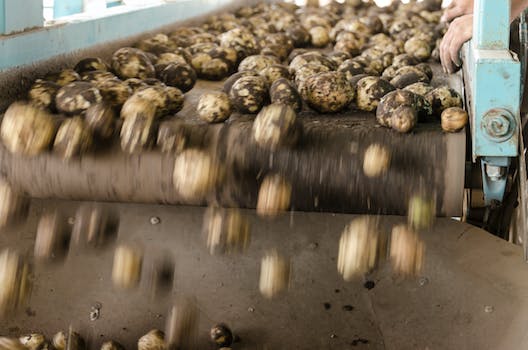
Tech in Agriculture: The Future of Farming
-
Table of Contents
is Here.
Introduction
The future of farming is being revolutionized by technology. From precision agriculture to autonomous tractors, technology is transforming the way farmers grow and manage their crops. By leveraging the power of data, farmers can now make more informed decisions about their crops, leading to higher yields and greater efficiency. Technology is also helping to reduce the environmental impact of farming, with more sustainable practices and improved water management. With the help of technology, farmers can now produce more food with fewer resources, helping to feed a growing global population.
How Technology is Revolutionizing the Agriculture Industry
The agriculture industry is undergoing a revolution, and technology is at the forefront of this transformation. From precision agriculture to the use of drones, the industry is leveraging the latest advancements in technology to increase efficiency, reduce costs, and improve yields.
One of the most significant changes in the agriculture industry is the use of precision agriculture. This technology uses sensors, GPS, and other data-driven tools to monitor and manage crops. By collecting data on soil conditions, weather, and other factors, farmers can make more informed decisions about when and how to plant, irrigate, and harvest their crops. This helps them maximize yields and reduce costs.
Another way technology is revolutionizing the agriculture industry is through the use of drones. Drones can be used to monitor crops, detect pests, and even deliver fertilizers and pesticides. They can also be used to survey land and create detailed maps of fields. This helps farmers make more informed decisions about how to manage their land.
Robotics is also playing a role in the agriculture industry. Robots can be used to automate tasks such as planting, weeding, and harvesting. This helps reduce labor costs and increase efficiency.
Finally, the use of artificial intelligence (AI) is helping farmers make better decisions. AI can be used to analyze data and provide insights into crop health, soil conditions, and other factors. This helps farmers make more informed decisions about how to manage their crops.
The agriculture industry is undergoing a revolution, and technology is at the forefront of this transformation. From precision agriculture to the use of drones, robots, and AI, the industry is leveraging the latest advancements in technology to increase efficiency, reduce costs, and improve yields. This is helping farmers around the world produce more food with fewer resources.
The Benefits of Automation in Agriculture
The agricultural industry is one of the oldest and most important industries in the world. As the population continues to grow, so does the demand for food. To meet this demand, farmers must find ways to increase their productivity and efficiency. Automation is one of the most effective ways to do this.
Automation in agriculture can help farmers increase their yields, reduce labor costs, and improve the quality of their products. Automated systems can be used to monitor and control irrigation, fertilization, and pest control. This can help farmers save time and money by reducing the amount of manual labor required. Automation can also help farmers reduce their environmental impact by reducing the amount of water and fertilizer used.
Automation can also help farmers increase their yields by improving the accuracy of their planting and harvesting. Automated systems can be used to monitor soil conditions, crop growth, and weather conditions. This can help farmers make more informed decisions about when to plant and harvest their crops. Automation can also help farmers reduce their labor costs by reducing the amount of time spent on manual tasks such as weeding and harvesting.
Finally, automation can help farmers improve the quality of their products. Automated systems can be used to monitor the quality of the soil, water, and fertilizer used. This can help farmers ensure that their crops are of the highest quality. Automation can also help farmers reduce the amount of waste produced by their operations.
Automation in agriculture is an effective way to increase productivity and efficiency. It can help farmers save time and money, reduce their environmental impact, and improve the quality of their products. Automation is an important tool for farmers to use in order to meet the growing demand for food.
Exploring the Potential of Drones in Agriculture

The use of drones in agriculture is becoming increasingly popular as farmers look for ways to increase efficiency and reduce costs. Drones are being used to monitor crops, detect pests and diseases, and even deliver fertilizers and pesticides. But what other potential applications do drones have in the agricultural sector?
One of the most promising applications of drones in agriculture is precision agriculture. This involves using drones to collect data on crop health, soil conditions, and other factors that can affect crop yields. This data can then be used to make informed decisions about crop management, such as when to irrigate, fertilize, or apply pesticides.
Drones can also be used to monitor livestock. By using drones equipped with cameras, farmers can keep an eye on their herds and detect any signs of illness or injury. This can help farmers respond quickly to any health issues and ensure their animals are well cared for.
Drones can also be used to deliver fertilizers and pesticides to crops. This can help reduce the amount of time and money spent on manual application of these products, as well as reduce the risk of human error.
Finally, drones can be used to survey land for potential agricultural use. By using drones equipped with cameras and sensors, farmers can quickly and accurately assess the suitability of a piece of land for farming. This can help them make informed decisions about where to invest their resources.
The potential applications of drones in agriculture are vast, and the technology is only just beginning to be explored. As the technology continues to develop, we can expect to see more innovative uses of drones in the agricultural sector.
The Impact of Big Data on Farming
Big data is revolutionizing the farming industry, allowing farmers to make more informed decisions and increase their efficiency. By leveraging data from a variety of sources, farmers can gain insights into their operations and make better decisions about how to manage their land, crops, and livestock.
Big data can be used to monitor soil conditions, weather patterns, and crop yields. This information can be used to optimize planting and harvesting schedules, as well as to identify areas of the farm that may need additional attention. By understanding the conditions of their land, farmers can make more informed decisions about when and where to plant, as well as how to best manage their crops.
Big data can also be used to monitor livestock health and performance. By tracking the health and behavior of their animals, farmers can identify potential problems before they become serious. This can help them to take preventive measures to ensure the health and well-being of their animals.
Big data can also be used to analyze market trends and identify opportunities for farmers to increase their profits. By understanding the current market conditions, farmers can make more informed decisions about when and where to sell their products. This can help them to maximize their profits and ensure that they are getting the best price for their goods.
Overall, big data is transforming the farming industry, allowing farmers to make more informed decisions and increase their efficiency. By leveraging data from a variety of sources, farmers can gain insights into their operations and make better decisions about how to manage their land, crops, and livestock. This can help them to maximize their profits and ensure that they are getting the best price for their goods.
The Role of Artificial Intelligence in Agriculture
The agricultural industry is undergoing a digital transformation, and artificial intelligence (AI) is playing a major role in this shift. AI is being used to increase crop yields, reduce costs, and improve the sustainability of farming operations.
AI-driven technologies are helping farmers make better decisions about when and how to plant, irrigate, and harvest their crops. For example, AI-powered sensors can monitor soil moisture levels and provide farmers with real-time data about the health of their crops. This data can be used to optimize irrigation schedules and ensure that crops are receiving the right amount of water.
AI is also being used to improve the accuracy of crop forecasting. By analyzing historical data and current weather conditions, AI-powered algorithms can predict the yield of a crop before it is planted. This information can help farmers make more informed decisions about which crops to plant and when.
AI is also being used to detect and diagnose crop diseases. AI-powered cameras can detect signs of disease in crops and alert farmers to potential problems. This can help farmers take action quickly to prevent the spread of disease and protect their crops.
Finally, AI is being used to improve the efficiency of agricultural operations. AI-powered robots can be used to automate tasks such as weeding, planting, and harvesting. This can help reduce labor costs and increase productivity.
The agricultural industry is embracing AI to improve the efficiency and sustainability of farming operations. AI-driven technologies are helping farmers make better decisions, increase yields, and reduce costs. As AI continues to evolve, it will become an even more important tool for the agricultural industry.
Q&A
1. What is precision agriculture?
Precision agriculture is a farming management concept that uses technology to improve the efficiency and productivity of agricultural operations. It involves the use of sensors, GPS, drones, and other technologies to collect data about the soil, crops, and environment, and then use that data to make informed decisions about how to manage the farm.
2. How can technology help farmers?
Technology can help farmers in a variety of ways. It can help them monitor and manage their crops more efficiently, reduce costs, increase yields, and improve the quality of their products. Technology can also help farmers make better decisions about when to plant, irrigate, and harvest their crops.
3. What are the benefits of using technology in agriculture?
The benefits of using technology in agriculture include increased efficiency, improved yields, reduced costs, and improved environmental sustainability. Technology can also help farmers make better decisions about when to plant, irrigate, and harvest their crops.
4. What are the challenges of using technology in agriculture?
The challenges of using technology in agriculture include the cost of purchasing and maintaining the technology, the need for specialized training, and the potential for data security breaches. Additionally, some farmers may be reluctant to adopt new technologies due to a lack of understanding or fear of the unknown.
5. What is the future of agriculture?
The future of agriculture is likely to involve more technology and automation. Farmers will be able to use data-driven decision-making to increase efficiency and productivity, while also reducing costs and improving environmental sustainability. Additionally, new technologies such as artificial intelligence and robotics may be used to automate certain tasks, such as planting and harvesting.
Conclusion
The future of farming is bright, and technology is playing a major role in making it so. With the help of technology, farmers are able to increase their yields, reduce their costs, and improve their sustainability. Technology is also helping to make farming more efficient and more profitable. As technology continues to evolve, it will continue to revolutionize the way we farm and the way we feed the world.






